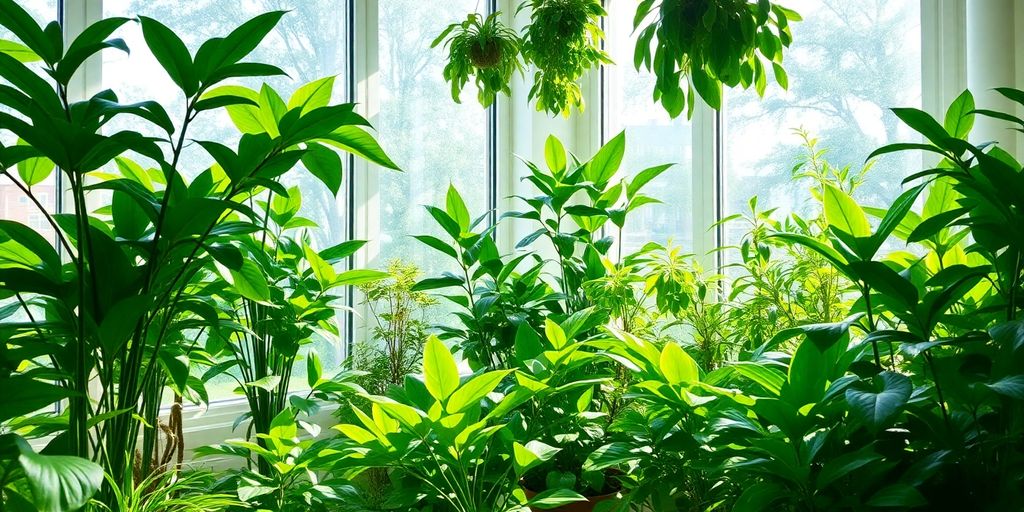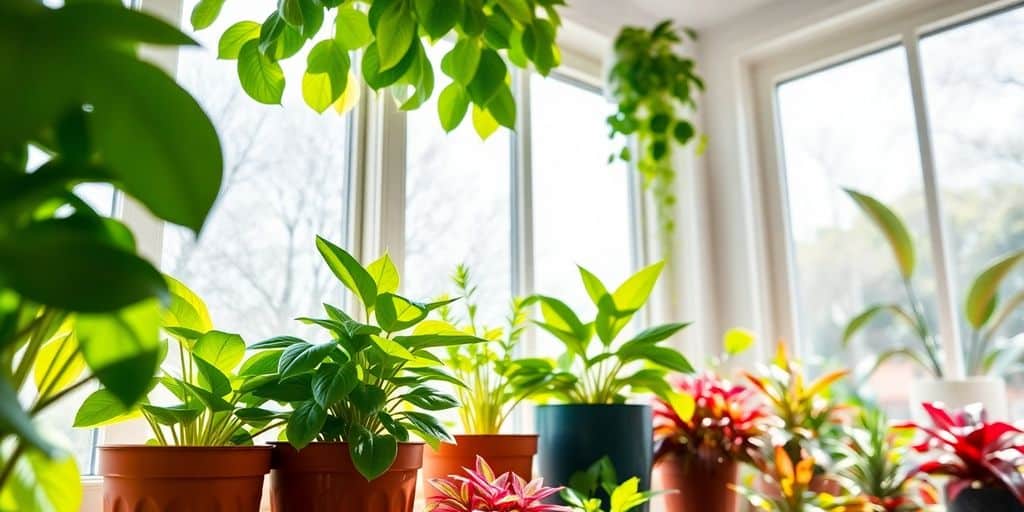How to care for plants near windows is a key topic for anyone looking to create a thriving indoor garden. The position of your windows and the type of plants you choose can make all the difference. With the right attention, even a sunny windowsill can become a plant paradise.
Light, temperature, and air circulation are just a few factors that impact plant health by the window. Understanding these elements helps ensure your green companions get exactly what they need. Small adjustments can lead to vibrant, long-lasting growth.
In this guide, you’ll find essential tips to make your plants flourish in window spaces. Whether you’re a beginner or a plant lover looking to level up, there’s something here for you. Let’s explore how to turn your window area into a botanical success.
Key takeaways
- Know the light needs of your plants based on window direction and adjust as seasons change.
- Keep humidity levels high for tropical plants and maintain stable temperatures to avoid stress.
- Water only when needed and use the right type of fertilizer to support healthy growth.
Understanding light requirements for plants near windows

Alright, so you wanna put some plants by the window, huh? Smart move! But before you go plonking just any plant down, let’s talk about light. It’s not as simple as just “bright” or “dark.” Different windows give different kinds of light, and plants are picky eaters when it comes to sunshine.
I learned this the hard way when I put a fern in a south-facing window and basically watched it crisp up like a potato chip. Don’t be like me!
Identifying window orientations
Okay, first things first: which way does your window face? This is key. South-facing windows are the light hogs, giving the most intense light. East-facing windows give you that sweet morning sun, while west-facing windows offer afternoon rays. North-facing windows? They’re the chill ones, offering the least amount of direct light. I usually tell folks to think of it like this:
- South: Sunbather’s paradise (but watch out for sunburn!)
- East: Gentle wake-up call
- West: Afternoon delight (can get intense, though)
- North: Shady retreat
Knowing this helps you pick the right plants. Cacti and succulents? They’ll probably dig a south-facing window. Ferns and snake plants? North-facing might be more their speed. It’s all about matching the plant to the window’s vibe.
Adjusting to seasonal light changes
Now, here’s a little secret: the light coming through your windows changes throughout the year. Crazy, right? In the summer, that south-facing window might be scorching, while in the winter, it’s a welcome dose of sunshine.
This means you might need to move your plants around a bit. I usually do a little plant shuffle in the spring and fall to make sure everyone’s getting the right amount of light. A plant that’s thriving in a south-facing window in January might need to move to an east-facing one come July.
Keep an eye on your plants, and they’ll tell you what they need. If the leaves are looking pale or scorched, it’s time for a change of scenery. Also, don’t forget to clean your windows! Dirty windows can block a surprising amount of light, and nobody wants that.
Maintaining humidity and temperature for optimal growth

Creating a humid environment
Okay, so, humidity. It’s a big deal, especially if you’re trying to keep tropical plants happy indoors. I learned this the hard way when my poor fern started looking like it was auditioning for a desert scene. Most houseplants thrive with humidity levels between 40-60%. Here’s what I do to keep things nice and moist:
- Group ‘em up: Plants release moisture through transpiration, so bunching them together creates a little humid microclimate. It’s like they’re all sharing a secret of how to stay hydrated.
- Pebble trays are your friend: I put a layer of pebbles in a tray, add water, and then set the plant on top (making sure the pot isn’t actually sitting in the water, or you’ll get root rot). As the water evaporates, it boosts the humidity right around the plant. It’s cheap and easy.
- Humidifier to the rescue: If you’re serious about your plants (and your own sinuses), a humidifier is a great investment. I run mine during the dry winter months, and everyone’s much happier.
Keeping temperatures stable
Plants are drama queens when it comes to temperature. They don’t like surprises! I try to keep things as consistent as possible. Ideally, you want to aim for daytime temperatures between 65-75°F (18-24°C) and a slight drop at night, maybe down to 55-65°F (13-18°C).
Here’s what I’ve found works:
- Keep ‘em away from drafts: Windowsills can be tricky because they can get cold in the winter. Also, keep plants away from heating vents or air conditioners. Those blasts of hot or cold air are not their friends.
- Mind the microclimates: Even within a room, temperatures can vary. A spot near a sunny window might be much warmer than a corner. Pay attention to where you put your plants and how the temperature changes throughout the day.
- Insulate if needed: If you’ve got a drafty window, consider using some weather stripping or even just a thick curtain to help insulate the area around your plants. It makes a difference!
Watering and feeding plants effectively
Alright, let’s talk about keeping your plants hydrated and fed. It’s not rocket science, but it’s easy to mess up, trust me, I’ve been there! Finding that sweet spot is key to keeping your green buddies happy, especially those plants soaking up the sun by the window.
Signs of over-watering and under-watering
Okay, so how do you know if you’re drowning or starving your plants? It’s all about paying attention.
- Over-watering can be sneaky. You might see yellowing leaves, or the soil might stay soggy for days. Root rot is a real danger, and nobody wants that. If the leaves are starting to look a little washed out, that’s also a bad sign.
- Under-watering is a bit more obvious. The leaves will droop, feel dry and crispy, and the soil will be bone dry to the touch. Sometimes, the leaves will even have scorched patches.
The trick is to check the soil before you water. Stick your finger in about an inch or two. If it feels dry, give ‘em a drink. If it’s still moist, hold off for a bit. I usually use my index finger, but hey, you do you.
Choosing the right fertilizer
Now, let’s talk food. Plants need nutrients, just like us. But you can’t just throw any old fertilizer at them. You gotta pick the right one.
- Liquid fertilizers are easy to use and get absorbed quickly. I like to use these during the growing season when my plants are really chowing down.
- Slow-release fertilizers are great if you’re a bit forgetful (like me sometimes). They release nutrients gradually over a few months, so you don’t have to worry about feeding your plants every week.
- Organic fertilizers are a good option if you’re trying to keep things natural. They’re usually made from stuff like compost or manure, so they’re gentle on your plants and good for the environment.
Always follow the instructions on the fertilizer label. More isn’t always better. Over-fertilizing can burn your plants and do more harm than good. And remember, plants need less food in the winter when they’re not growing as much. It’s all about balance, y’all!
Wrapping It Up
Taking care of your plants near windows doesn’t have to be complicated. Just remember to pay attention to their light needs, keep an eye on watering, and adjust for temperature changes. It’s all about finding the right balance.
If you notice your plants struggling, don’t panic—just tweak their environment a bit. With a little patience and observation, you’ll have thriving greenery in no time. So, go ahead and give your plants the love they need, and enjoy the beauty they bring to your space!
Frequently asked questions
What type of light do plants need near windows?
Plants near windows need different types of light depending on the direction the window faces. South-facing windows give the most light, while north-facing windows provide less. It’s important to know how much light your plant needs to thrive.
How can I tell if my plant needs more water?
If your plant’s leaves are wilting or the soil feels very dry, it might need more water. Always check the soil first, and water your plant if the top two inches are dry.
What should I do if my plant is getting too much sunlight?
If you notice burnt leaves or if the plant looks washed out, it might be getting too much sun. You can move it to a spot with less direct sunlight or use a sheer curtain to filter the light.
